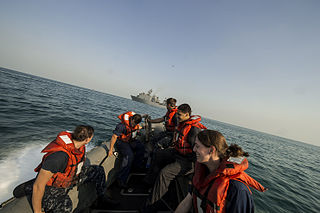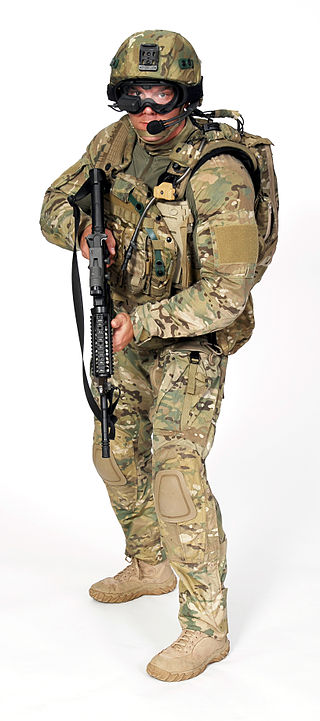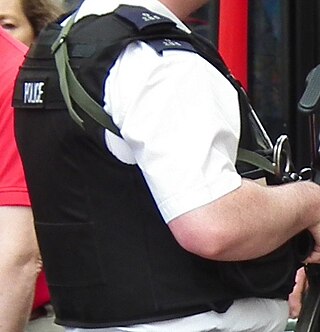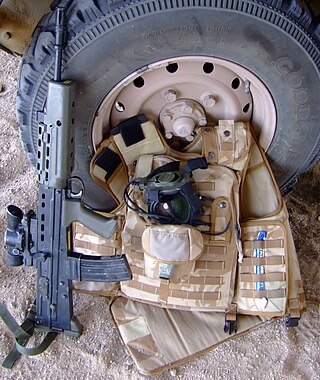
Armour or armor is a covering used to protect an object, individual, or vehicle from physical injury or damage, especially direct contact weapons or projectiles during combat, or from a potentially dangerous environment or activity. Personal armour is used to protect soldiers and war animals. Vehicle armour is used on warships, armoured fighting vehicles, and some mostly ground attack combat aircraft.

A bulletproof vest, also known as a ballistic vest or a bullet-resistant vest, is an item of body armour that helps absorb the impact and reduce or stop penetration to the torso by firearm-fired projectiles and fragmentation from explosions. The vest may come in a soft form, as worn by many police officers, prison officers, security guards, and some private citizens, used to protect against stabbing attacks or light projectiles, or hard form, using metallic or para-aramid components. Soldiers and police tactical units wear hard armour, either in conjunction with soft armour or alone, to protect against rifle ammunition or fragmentation.
The Interceptor Multi-Threat Body Armor System (IBA) is a bullet-resistant body armor system that was used by the United States Armed Forces during the 2000s, with some limited usage into the mid-2010s. IBA and its design replaced the older standardized fragmentation protective Personnel Armor System for Ground Troops (PASGT) body armor system that was designed in the late 1970s and introduced in the early 1980s.

Personnel Armor System for Ground Troops is a combat helmet and ballistic vest that was used by the United States military from the early 1980s until the mid-2000s, when the helmet and vest were succeeded by the Lightweight Helmet (LWH), Modular Integrated Communications Helmet (MICH), and Interceptor Body Armor (IBA) respectively.

Body armor, personal armor, armored suit (armoured) or coat of armor, among others, is protective clothing designed to absorb or deflect physical attacks. Historically used to protect military personnel, today it is also used by various types of police, private security guards, or bodyguards, and occasionally ordinary citizens. Today there are two main types: regular non-plated body armor for moderate to substantial protection, and hard-plate reinforced body armor for maximum protection, such as used by combatants.

A personal flotation device is a flotation device in the form of a vest or suit that is worn by a user to prevent the wearer from drowning in a body of water. The device will keep the wearer afloat with their head and mouth above the surface – they do not have to swim or tread water in order to stay afloat and can even be unconscious.

The Small Arms Protective Insert (SAPI) is a ceramic ballistic plate used by the United States Armed Forces. It was first used in the Ranger Body Armor and Interceptor Body Armor, both are ballistic vests. It is now also used in the Improved Outer Tactical Vest as well as the Modular Tactical Vest, in addition to commercially available "plate carriers". The Kevlar Interceptor vest itself is designed to stop projectiles up to and including 9×19mm Parabellum submachine gun rounds, in addition to fragmentation. To protect against higher-velocity rifle rounds, SAPI plates are needed.

Future Force Warrior was a United States military advanced technology demonstration project that was part of the Future Combat Systems project. The FFW project sought to create a lightweight, fully integrated infantryman combat system. It was one technology demonstration project in a series of network-centric, next-generation infantry combat projects the U.S. military have developed over the past decade, such as the Soldier Integrated Protective Ensemble technology demonstration program, Land Warrior, and Transformation of the United States Army.

The Modular Integrated Communications Helmet (MICH) is a U.S. combat helmet and one of several used by the U.S. military. It was developed by the United States Army Soldier Systems Center to be the next generation of protective combat helmets for use by the U.S. Army.

The Advanced Combat Helmet (ACH) is the United States Army's current combat helmet, used since the early 2000s. It was developed by the United States Army Soldier Systems Center, the U.S. Army Special Operations Command, and the U.S. Army Research Laboratory to be the next generation of protective combat helmets for use by the American ground forces. The ACH is derived from the Modular Integrated Communications Helmet.

The IIFS was introduced in 1988, to serve as a fighting and existence carrying system—a possible replacement for the All-purpose Lightweight Individual Carrying Equipment employed and fielded by United States Armed Forces since 1973.

A stab vest or stab proof vest is a reinforced piece of body armor, worn under or over other items of clothing, which is designed to resist knife attacks to the chest, back and sides. Stab vests are different from bulletproof vests, most of which offer protection against firearms but afford little against stabbing with sharp-tipped objects such as knives; most stab vests afford less protection against bullets, particularly those of high caliber, but are designed to prevent serious injury by prohibiting knife penetration beyond a few millimeters. Stab vests are also needle and slash proof.
The Helicopter Aircrew Breathing Device or HABD is an item of survival equipment which was adopted by the military to increase the chances of survival for embarked troops and aircrew trapped in an aircraft which has ditched. It is a form of self contained underwater breathing apparatus (scuba) which consists of a small cylinder pressurized with atmospheric air and first stage regulator worn in a pouch on the user's life vest; a pressure gauge; an air hose and a second-stage demand regulator that delivers air to the user's mouth when the internal pressure of the mouthpiece drops during inhalation, and is ruggedly constructed to survive impacts associated with emergency ditchings.

The Modular Tactical Vest is a ballistic vest originally adopted by the United States Marine Corps in 2006. The MTV was designed as a solution to shortcomings in the Interceptor Body Armor (IBA) and was selected after a rigorous proposal and examination process by the Marine Corps. The MTV provides better protection levels than the IBA, although it uses the same Small Arms Protective Insert (SAPI) plates. The MTV weighs 30 pounds (14 kg), three pounds more than the IBA, but is designed to more effectively distribute its weight throughout the wearer's torso.

Osprey body armour is a system of body armour used by the British Armed Forces. The system is in its fourth iteration following extensive development and engagement with front line users.

The Improved Outer Tactical Vest (IOTV) is an enhanced version of, and a replacement for, the older Outer Tactical Vest (OTV) variant of the Interceptor Multi-Threat Body Armor System, as fielded by the United States Army. The IOTV is compatible with the Deltoid and Axillary Protector System (DAPS) components, ESAPI, Enhanced Side Ballistic Inserts (ESBI), as well as the OTV's groin protector. It has a flame-resistant standalone shirt, the Army Combat Shirt, designed specifically for use with the IOTV.

The U.S. Woodland is a camouflage pattern that was used as the default camouflage pattern issued to the United States Armed Forces from 1981, with the issue of the Battle Dress Uniform, until its replacement in the mid to late 2000s. It is a four color, high contrast disruptive pattern with irregular markings in green, brown, sand and black. It is also known unofficially by its colloquial moniker of "M81" after the Battle Dress Uniform it was first used on, though this term was not officially used by the U.S. military.
The Amphibious Assault Vest, Quick-Release, or FSBE AAV QR, is a light-weight assault vest system that incorporates both protection and cargo retention. Protection includes soft armor coupled with hard ballistic inserts. Cargo retention capabilities include various pouches and pockets attached via standard PALS webbing. The entire FSBE kit includes the vest body, a throat protector, a groin protector and an assortment of load bearing pouches. A fully loaded vest with armor plates can prove quite heavy, and is typically used only in high-risk direct action (DA) missions.
Air Warrior (AW) is a modular, integrated, rapidly reconfigurable combat aircrew ensemble designed for U.S. Army aircrews. Previous aviation life support equipment consisted of a non-integrated assemblage of protective and survival gear. AW uses a systems approach to equipping the aircrew and closes the capability gap between human and machine. Fielded incrementally in blocks to rapidly provide enhanced capabilities to the warfighter, AW leverages and integrates clothing and equipment, such as the Army Aircrew Combat Uniform and ballistic protection, from other product managers. As of April 2010, more than 18,000 AW systems had been fielded in support of Operation Iraqi Freedom and Operation Enduring Freedom.













